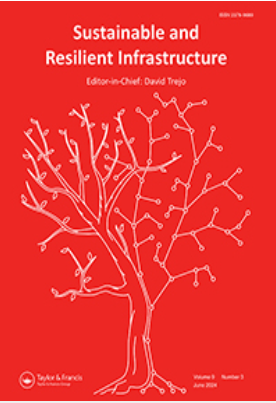Bayesian model for sustainable, resilient, and cost-effective concrete mixtures
IF 2.2
Q2 ENGINEERING, CIVIL
引用次数: 0
Abstract
ABSTRACT This work develops a Bayesian model that can be used to proportion sustainable, resilient, and cost-effective concrete mixtures based on stakeholder preferences. Traditionally, the decision-making process for proportioning concrete mixtures is centered around meeting target specifications, such as slump and compressive strength, and attributes such as sustainability and durability are given minimal importance. However, in the global push towards green infrastructure, sustainability plays a major role and must be considered to the same degree as engineering attributes. The model developed herein accounts for embodied carbon footprint, cost, and time to corrosion initiation, apart from the target specifications commonly used to proportion concrete mixtures. The developed model is demonstrated through two case studies: one targeting the average industrial embodied carbon footprint for a concrete mixture and the other targeting a reduction of 40% from the industry’s carbon footprint average. This model can also be used to perform data visualization and sensitivity analyses.贝叶斯模型的可持续,弹性,和具有成本效益的混凝土混合物
摘要本工作开发了一个贝叶斯模型,可用于根据利益相关者的偏好对可持续、有弹性和具有成本效益的混凝土混合物进行配比。传统上,混凝土混合物配比的决策过程以满足坍落度和抗压强度等目标规范为中心,而可持续性和耐久性等属性的重要性最低。然而,在全球推动绿色基础设施的过程中,可持续性发挥着重要作用,必须与工程属性同等重视。除了通常用于配比混凝土混合物的目标规范外,本文开发的模型还考虑了具体的碳足迹、成本和腐蚀引发时间。通过两个案例研究证明了所开发的模型:一个是针对混凝土混合物的平均工业碳足迹,另一个是将工业碳足迹平均值降低40%。该模型还可用于执行数据可视化和敏感性分析。
本文章由计算机程序翻译,如有差异,请以英文原文为准。
求助全文
约1分钟内获得全文
求助全文
来源期刊

Sustainable and Resilient Infrastructure
ENGINEERING, CIVIL-
CiteScore
7.60
自引率
10.20%
发文量
34
期刊介绍:
Sustainable and Resilient Infrastructure is an interdisciplinary journal that focuses on the sustainable development of resilient communities.
Sustainability is defined in relation to the ability of infrastructure to address the needs of the present without sacrificing the ability of future generations to meet their needs. Resilience is considered in relation to both natural hazards (like earthquakes, tsunami, hurricanes, cyclones, tornado, flooding and drought) and anthropogenic hazards (like human errors and malevolent attacks.) Resilience is taken to depend both on the performance of the built and modified natural environment and on the contextual characteristics of social, economic and political institutions. Sustainability and resilience are considered both for physical and non-physical infrastructure.
 求助内容:
求助内容: 应助结果提醒方式:
应助结果提醒方式:


